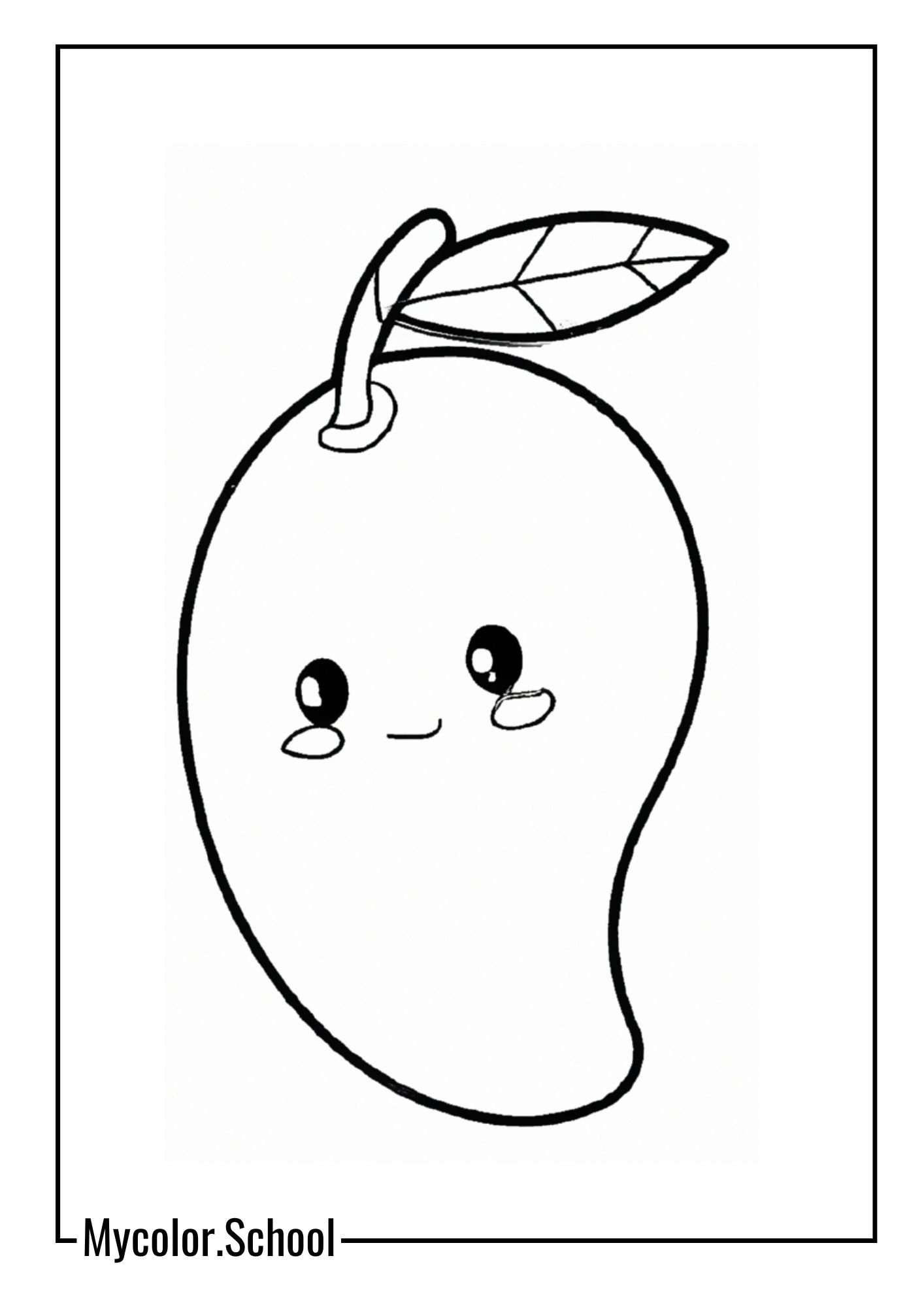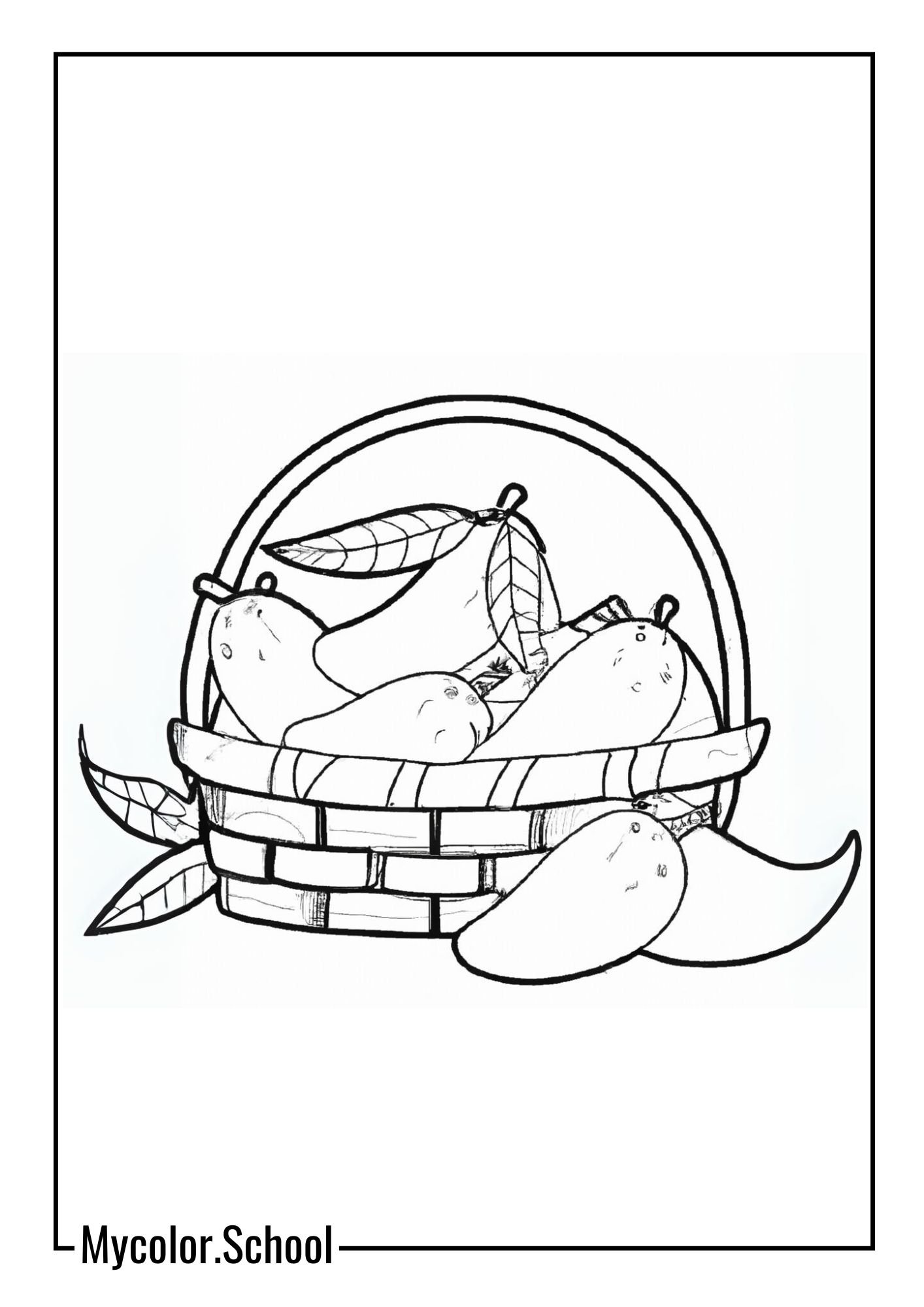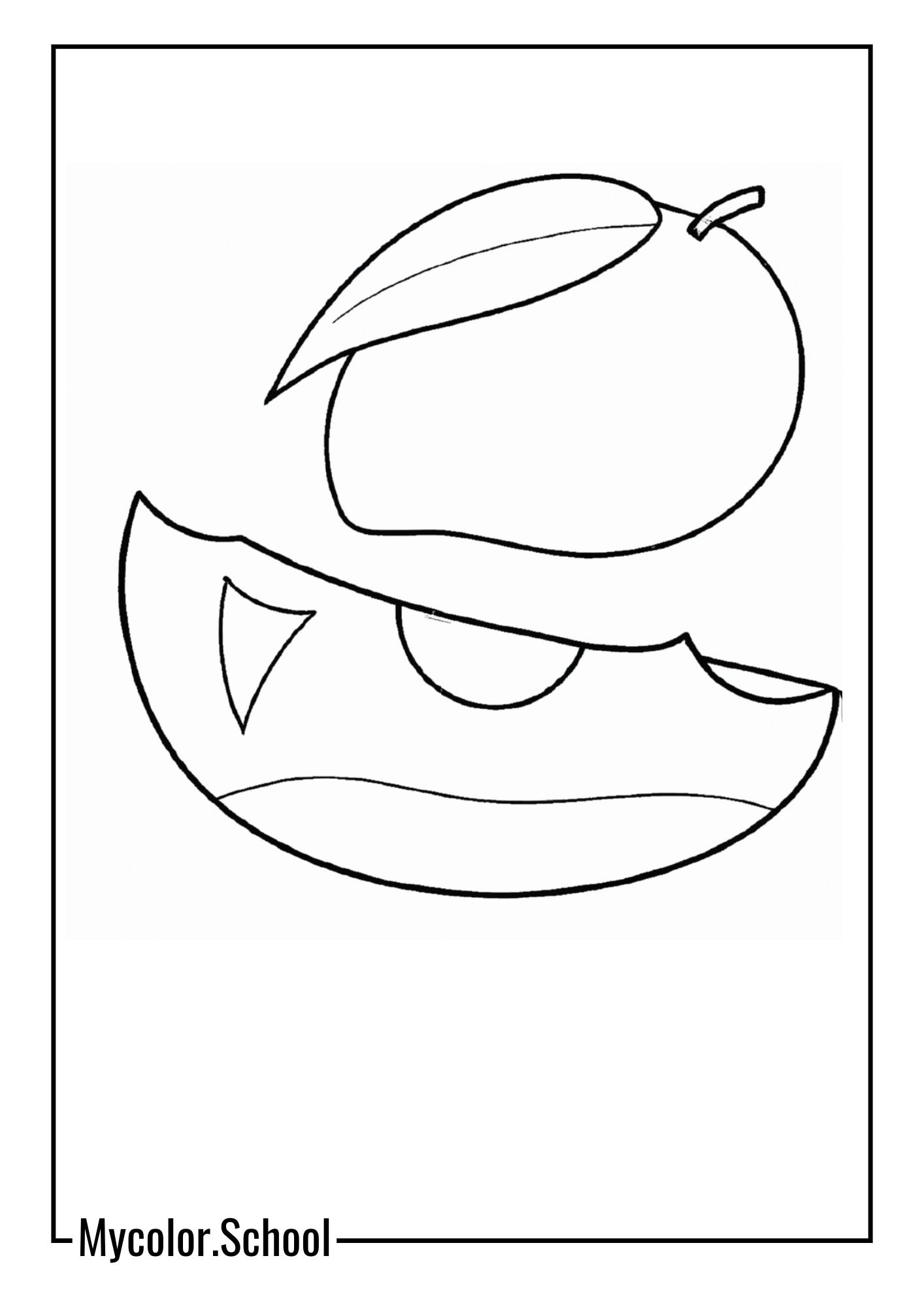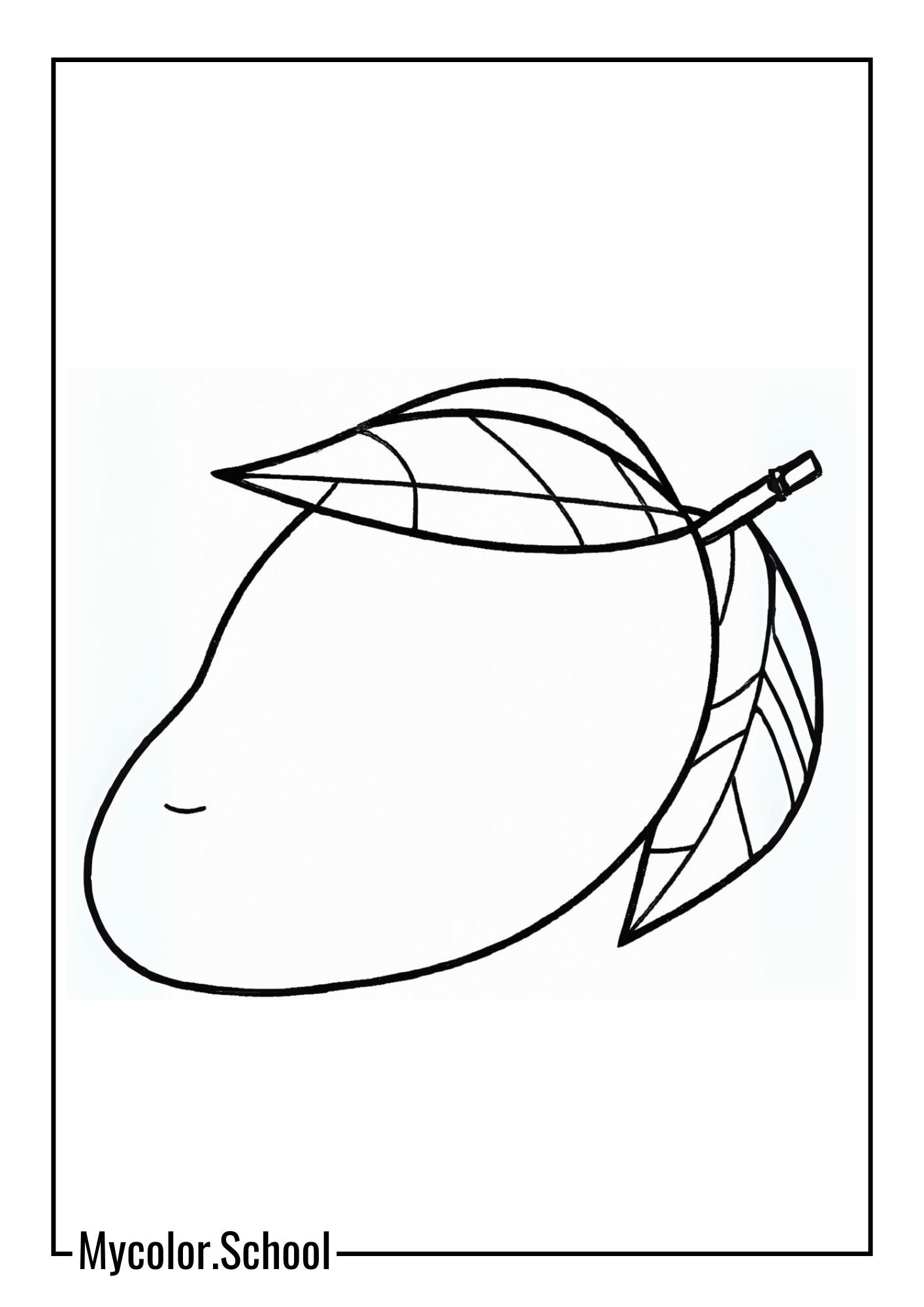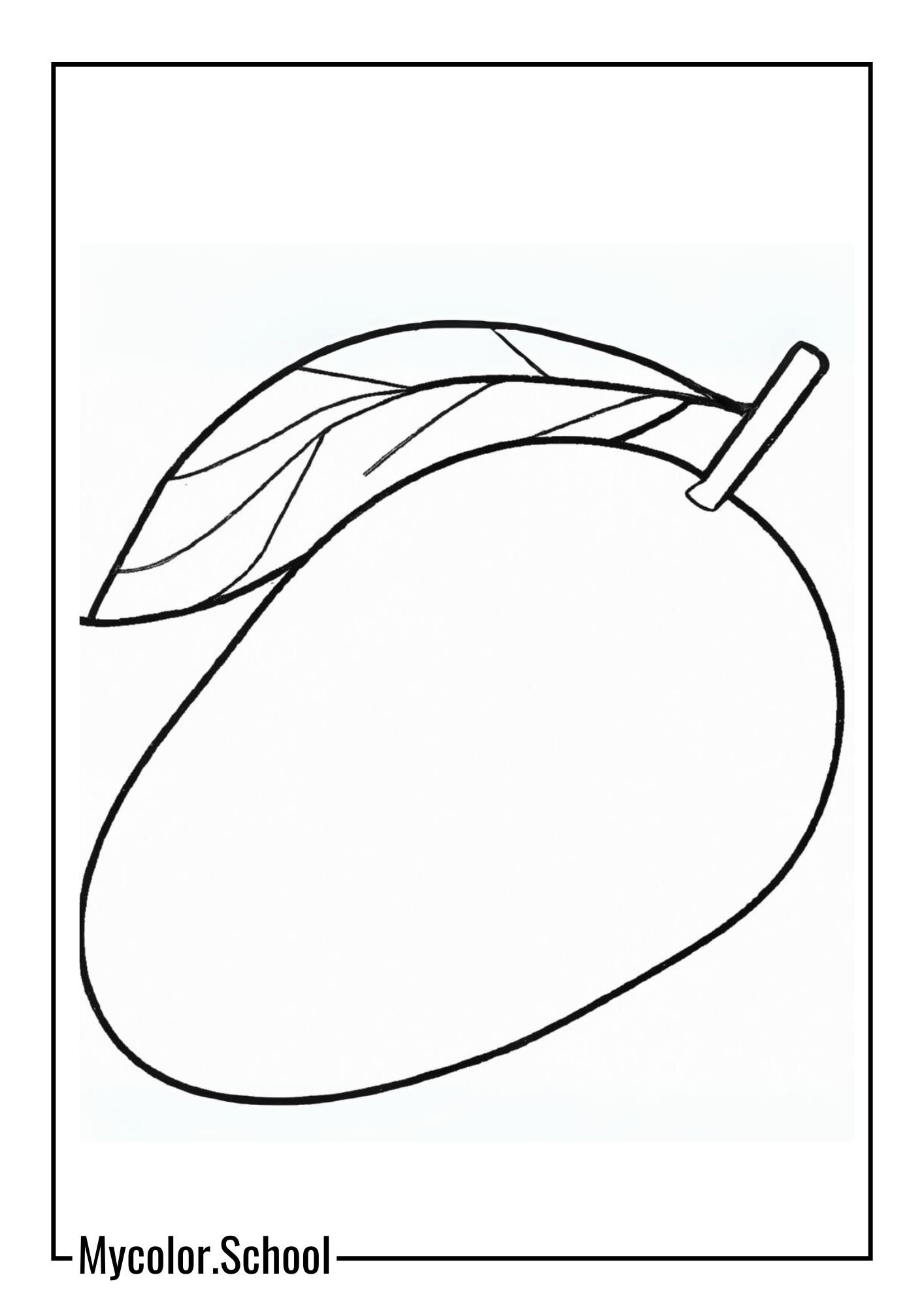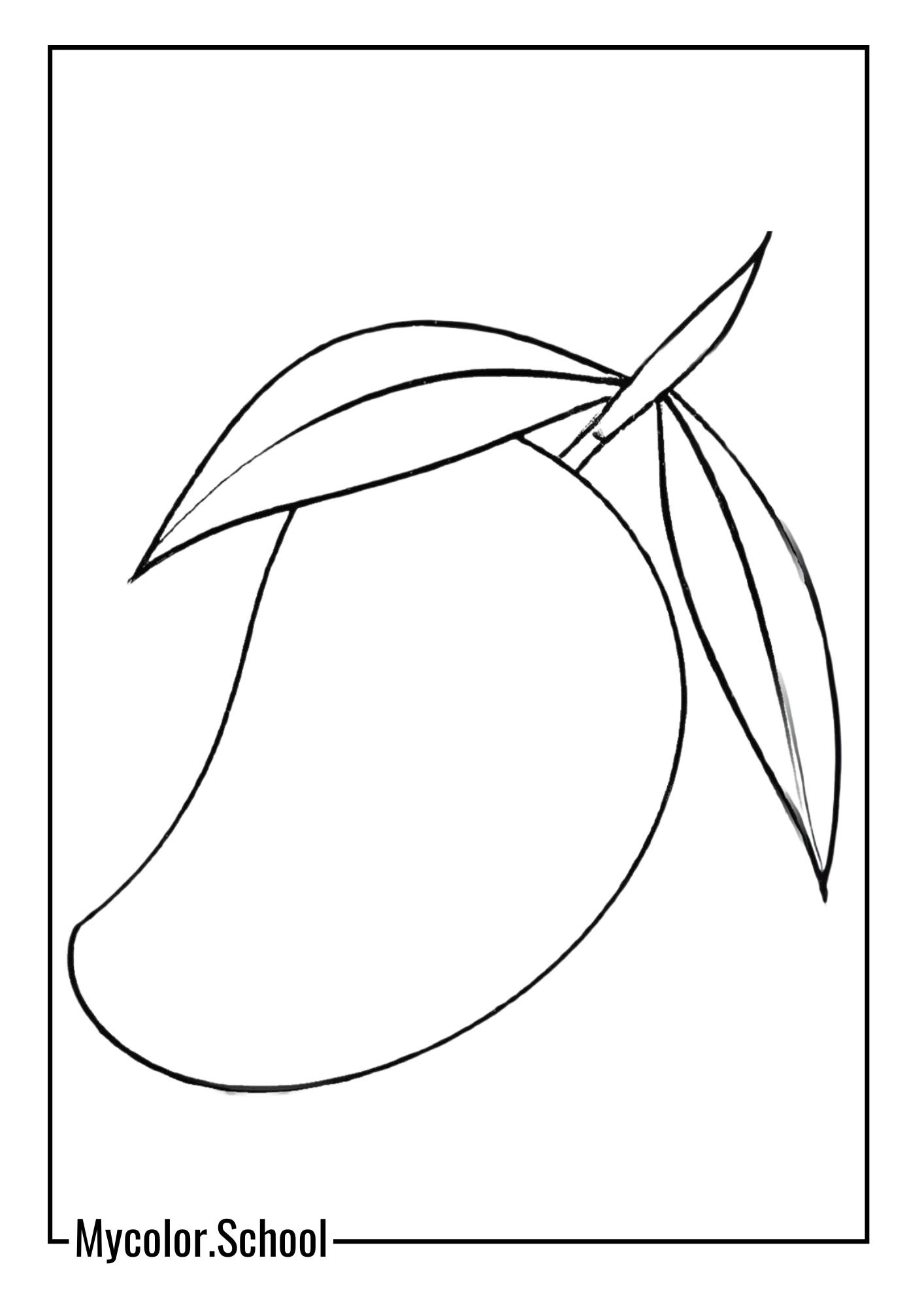7 Mango Coloring Pages
Table of Contents
- The Benefits of Using Mango Coloring Pages for Kids
- Exploring Different Mango Varieties through Coloring Pages
- How to Create Vibrant and Realistic Mango Coloring Pages
- Fun and Educational Activities with Mango Coloring Pages
- The History and Cultural Significance of Mangoes in Coloring Pages
- Mango Coloring Pages: A Creative Outlet for Stress Relief
- Engaging Storytelling with Mango Coloring Pages
- Mango Coloring Pages: A Tool for Teaching Fruit Nutrition to Children
- Mango Coloring Pages: Inspiring Tropical Artwork
- Mango Coloring Pages: A Fun Way to Learn about Life Cycles
Vibrant and Fun: Explore the World of Mango Coloring Pages!
The Benefits of Using Mango Coloring Pages for Kids
Mango coloring pages are a fantastic way to keep kids entertained while also providing them with numerous benefits. Coloring is not just a fun activity; it also helps children develop various skills and abilities. In this article, we will explore the benefits of using mango coloring pages for kids.
First and foremost, coloring pages help children improve their fine motor skills. When kids hold a crayon or a colored pencil and carefully color within the lines, they are strengthening the muscles in their hands and fingers. This improves their dexterity and hand-eye coordination, which are essential skills for many everyday tasks.
Furthermore, coloring pages can enhance a child’s creativity and imagination. By giving them a blank canvas to work with, they can choose the colors they want to use and create their own unique masterpiece. This freedom allows children to express themselves and think outside the box, fostering their creative thinking abilities.
Coloring also helps children develop their concentration and focus. When kids are engrossed in coloring, they are fully engaged in the activity, which requires them to pay attention to details and stay focused on the task at hand. This ability to concentrate can translate into better performance in school and other areas of life.
Moreover, coloring pages can be a great tool for teaching children about colors and shapes. Mango coloring pages, for example, can introduce kids to the vibrant shades of yellow and orange that are characteristic of this delicious fruit. They can also learn about different shapes by coloring the mangoes and their leaves. This combination of learning and fun makes coloring pages an effective educational tool.
In addition to these cognitive benefits, coloring pages can also have a positive impact on a child’s emotional well-being. Coloring has a calming effect on children, helping them relax and unwind. It can be a therapeutic activity that allows kids to express their emotions and relieve stress. Coloring can also boost a child’s self-esteem and confidence as they see their artwork come to life.
Furthermore, coloring pages can be a great bonding activity for parents and children. Sitting down together to color can create a special bonding experience, where parents can engage in meaningful conversations with their kids. It provides an opportunity for quality time and strengthens the parent-child relationship.
Lastly, mango coloring pages can be a source of inspiration for children. As they color the mangoes and the surrounding elements, they might develop an interest in fruits, nature, or even art. This newfound interest can lead to further exploration and learning, sparking their curiosity and broadening their horizons.
In conclusion, mango coloring pages offer numerous benefits for children. From improving fine motor skills and fostering creativity to enhancing concentration and emotional well-being, coloring pages are a valuable tool for child development. They provide a fun and educational activity that can be enjoyed by both kids and parents. So, why not grab some mango coloring pages and let your child’s imagination soar?
Exploring Different Mango Varieties through Coloring Pages
Mangoes are one of the most beloved fruits around the world. Their sweet and juicy flavor, combined with their vibrant colors, make them a favorite among both children and adults. If you’re looking for a fun and educational activity to do with your kids, why not try exploring different mango varieties through coloring pages?
Coloring pages are a great way to engage children in learning about different fruits and vegetables. They allow kids to use their creativity and imagination while also teaching them about the world around them. By coloring different mango varieties, children can learn about the diversity of this delicious fruit and develop an appreciation for its many flavors and colors.
One of the most popular mango varieties is the Alphonso mango. Known for its rich and creamy texture, the Alphonso mango is often referred to as the “king of mangoes.” Its bright orange color and sweet aroma make it a favorite among mango lovers. By coloring a picture of an Alphonso mango, children can learn about its distinct characteristics and understand why it is so highly regarded.
Another popular mango variety is the Tommy Atkins mango. This mango is known for its vibrant red and green skin and its sweet and tangy flavor. It is a versatile mango that can be used in a variety of dishes, from salads to smoothies. By coloring a picture of a Tommy Atkins mango, children can learn about its unique appearance and taste and discover how it differs from other mango varieties.
The Kent mango is another variety that is worth exploring through coloring pages. This mango has a greenish-yellow skin with a red blush and a sweet and juicy flesh. It is often used in desserts and is known for its smooth and buttery texture. By coloring a picture of a Kent mango, children can learn about its distinctive appearance and taste and discover how it can be used in different recipes.
The Keitt mango is yet another variety that can be explored through coloring pages. This mango has a green skin that turns yellow as it ripens and a sweet and tangy flavor. It is often used in salsas and chutneys and is known for its firm and fiberless flesh. By coloring a picture of a Keitt mango, children can learn about its unique characteristics and understand how it can be used in different culinary creations.
By exploring different mango varieties through coloring pages, children can develop an appreciation for the diversity of this delicious fruit. They can learn about the different flavors, colors, and textures of mangoes and understand how they can be used in various dishes. Coloring pages provide a fun and interactive way for children to learn about the world around them while also developing their creativity and imagination.
So, the next time you’re looking for a fun and educational activity to do with your kids, why not try exploring different mango varieties through coloring pages? It’s a great way to engage children in learning about fruits and vegetables while also allowing them to express their creativity. Who knows, they might even discover a new favorite mango variety along the way!
How to Create Vibrant and Realistic Mango Coloring Pages
Mangoes are delicious tropical fruits that are loved by people of all ages. Their vibrant colors and unique shape make them a perfect subject for coloring pages. If you want to create vibrant and realistic mango coloring pages, here are some tips to help you get started.
Firstly, it’s important to choose the right colors for your mango coloring pages. Mangoes come in various shades of yellow, orange, and green. To make your coloring pages look realistic, try using different shades of these colors to create depth and dimension. Start with a light base color and gradually add darker shades to create shadows and highlights. This will give your mango coloring pages a more three-dimensional look.
To make your mango coloring pages even more vibrant, consider using colored pencils or markers with a high pigment concentration. These will give you more intense and saturated colors, making your mangoes look more realistic. Experiment with different brands and types of coloring materials to find the ones that work best for you.
When coloring your mangoes, pay attention to the texture of the fruit. Mangoes have a smooth skin with subtle bumps and ridges. To create a realistic texture, use short, light strokes to mimic the skin’s texture. You can also add some lines or dots to represent the fruit’s natural imperfections. This attention to detail will make your mango coloring pages look more lifelike.
Another important aspect to consider when creating realistic mango coloring pages is the background. Mangoes are often found in tropical settings, so consider adding some palm trees, coconuts, or a sunny sky to your coloring pages. This will help set the scene and make your mangoes look even more vibrant and realistic. Don’t be afraid to get creative with the background – you can even add some birds or butterflies to make your coloring pages more interesting.
To add a finishing touch to your mango coloring pages, consider adding some shading and blending. This will give your mangoes a more three-dimensional look and make them pop off the page. Use a blending tool or a cotton swab to gently blend the colors together, creating a smooth transition between shades. This technique will make your mango coloring pages look more professional and polished.
Remember, creating vibrant and realistic mango coloring pages is all about paying attention to detail and using the right colors and techniques. Take your time and have fun with it – coloring is a great way to relax and unleash your creativity. Whether you’re a beginner or an experienced artist, these tips will help you create beautiful mango coloring pages that will impress everyone who sees them. So grab your coloring materials and start creating your own tropical paradise with vibrant and realistic mango coloring pages.
Fun and Educational Activities with Mango Coloring Pages
Mango Coloring Pages
Mangoes are not only delicious fruits but also a great source of inspiration for fun and educational activities. One such activity is coloring pages featuring mangoes. These coloring pages can provide hours of entertainment for children while also teaching them about the fruit and its various aspects. Let’s explore the world of mango coloring pages and discover how they can be both fun and educational.
Coloring pages are a popular activity among children, and for a good reason. They allow kids to express their creativity and imagination while also improving their fine motor skills. Mango coloring pages offer a unique opportunity to combine this artistic expression with learning about a specific fruit. By coloring mangoes, children can learn about the fruit’s shape, color, and texture.
One way to make mango coloring pages more educational is by including additional elements related to the fruit. For example, you can add a tree with mangoes hanging from its branches or a basket filled with ripe mangoes. This way, children can learn about the mango tree and how the fruit is harvested and stored. You can also include other fruits and vegetables to create a more comprehensive scene, teaching children about healthy eating habits and the importance of a balanced diet.
Another way to make mango coloring pages educational is by including simple facts or trivia about the fruit. For instance, you can write a short sentence or two about the origin of mangoes, their nutritional value, or the different varieties of mangoes found around the world. This way, children not only color the fruit but also learn interesting facts about it. This can spark their curiosity and encourage them to explore more about mangoes.
Mango coloring pages can also be used as a tool to teach children about colors. You can provide a variety of coloring options, such as different shades of yellow, orange, and green, and encourage children to experiment with mixing colors to create their own unique mango hues. This activity can help children develop their color recognition skills and learn about color combinations.
To make the coloring experience even more enjoyable, you can turn it into a group activity. Gather a group of children and provide them with mango coloring pages and a set of coloring materials. Encourage them to share their ideas and techniques with each other, fostering a sense of collaboration and creativity. This can also be a great opportunity for children to practice their social skills and learn from one another.
In conclusion, mango coloring pages offer a fun and educational activity for children. By coloring mangoes, children can learn about the fruit’s shape, color, and texture while also improving their fine motor skills. Including additional elements related to mangoes and providing interesting facts can enhance the educational value of these coloring pages. Moreover, using different colors and turning it into a group activity can make the experience even more enjoyable and beneficial for children. So, grab some coloring materials and let the mango coloring adventure begin!
The History and Cultural Significance of Mangoes in Coloring Pages
Mangoes are not only delicious fruits but also have a rich history and cultural significance. It is no wonder that mango coloring pages have become popular among children and adults alike. These coloring pages not only provide a fun activity but also offer an opportunity to learn about the history and cultural significance of mangoes.
Mangoes have a long and fascinating history. They are believed to have originated in South Asia, specifically in India and Myanmar, over 4,000 years ago. From there, they spread to other parts of the world through trade and exploration. The fruit was highly valued by ancient civilizations, including the Egyptians, Greeks, and Romans, who considered it a symbol of love and fertility.
In many cultures, mangoes are associated with various myths and legends. For example, in Hindu mythology, the mango tree is considered sacred and is often associated with gods and goddesses. It is believed that Buddha himself meditated under the shade of a mango tree. In some African cultures, mangoes are believed to have healing properties and are used in traditional medicine.
The cultural significance of mangoes is not limited to mythology and legends. Mangoes have also played a role in art, literature, and music. In Indian art, mangoes are often depicted in paintings and sculptures, symbolizing abundance and prosperity. In literature, mangoes are often used as a metaphor for desire and longing. In music, mangoes have inspired songs and poems, celebrating their sweetness and beauty.
Mango coloring pages provide an opportunity to explore and celebrate the cultural significance of mangoes. Children can learn about different myths and legends associated with mangoes while coloring the pages. They can also learn about different varieties of mangoes and their unique characteristics. This can help children develop an appreciation for different cultures and traditions.
Coloring pages can also be a great way for adults to relax and unwind. Coloring has been shown to reduce stress and anxiety, and it can be a form of meditation. Mango coloring pages can provide a soothing and enjoyable activity for adults, allowing them to reconnect with their inner child and tap into their creativity.
In addition to their cultural significance, mangoes are also a nutritious fruit. They are rich in vitamins A and C, as well as dietary fiber. Mangoes are also a good source of antioxidants, which can help protect the body against various diseases. By coloring mango pages, children can also learn about the nutritional benefits of mangoes and the importance of incorporating fruits into their diet.
In conclusion, mango coloring pages offer a fun and educational activity for both children and adults. They provide an opportunity to learn about the history and cultural significance of mangoes, as well as their nutritional benefits. Whether you are a child or an adult, coloring mango pages can be a delightful and enriching experience. So grab your coloring pencils and let your creativity soar as you explore the world of mangoes through coloring!
Mango Coloring Pages: A Creative Outlet for Stress Relief
Mango Coloring Pages: A Creative Outlet for Stress Relief
In today’s fast-paced world, stress has become an inevitable part of our lives. From work pressures to personal responsibilities, it seems like there’s always something that demands our attention and leaves us feeling overwhelmed. However, finding healthy ways to cope with stress is crucial for our overall well-being. One such way is through the simple act of coloring, and mango coloring pages can be a great tool for stress relief.
Coloring has long been recognized as a therapeutic activity that promotes relaxation and mindfulness. It allows us to focus on the present moment, letting go of our worries and immersing ourselves in the creative process. The repetitive motion of coloring can be soothing, calming our minds and reducing anxiety. It’s no wonder that coloring books for adults have gained immense popularity in recent years.
Mango coloring pages offer a unique and refreshing twist to this popular trend. Mangoes, with their vibrant colors and juicy sweetness, evoke a sense of tropical paradise and relaxation. By coloring these pages, we can transport ourselves to a tranquil oasis, even if only in our imaginations. The process of choosing colors and filling in the intricate details of the mangoes can be a meditative experience, allowing us to escape from the chaos of everyday life.
Moreover, mango coloring pages provide a creative outlet for self-expression. As we color, we can experiment with different color combinations and shading techniques, giving each mango a unique personality. This creative freedom allows us to tap into our inner artist and explore our imagination. Whether we prefer realistic or abstract interpretations, mango coloring pages offer endless possibilities for artistic expression.
Not only does coloring provide stress relief, but it also offers numerous other benefits for our mental and emotional well-being. It can improve focus and concentration, as we become fully engrossed in the task at hand. Coloring also stimulates the brain’s reward system, releasing dopamine, a neurotransmitter associated with pleasure and motivation. This can boost our mood and provide a sense of accomplishment, even in the simplest of activities.
Furthermore, coloring can be a social activity that brings people together. Whether it’s coloring with friends, family, or even in a community setting, it fosters a sense of connection and camaraderie. Sharing our colored mango pages with others can spark conversations and create a shared experience. It’s a wonderful way to bond with loved ones and create lasting memories.
In conclusion, mango coloring pages offer a creative and enjoyable way to relieve stress and promote well-being. By engaging in this simple activity, we can find solace in the present moment, unleash our creativity, and experience the therapeutic benefits of coloring. So, the next time you feel overwhelmed by the demands of life, grab your colored pencils and immerse yourself in the world of mangoes. Let the vibrant colors and intricate details transport you to a place of tranquility and rejuvenation. Happy coloring!
Engaging Storytelling with Mango Coloring Pages
Mango Coloring Pages
Engaging Storytelling with Mango Coloring Pages
Coloring pages have long been a favorite pastime for children and adults alike. They provide a creative outlet and a way to relax and unwind. But did you know that coloring pages can also be a tool for engaging storytelling? Mango coloring pages, in particular, offer a unique opportunity to tell captivating stories while also exploring the vibrant world of this delicious fruit.
When it comes to engaging storytelling, the possibilities are endless with mango coloring pages. You can create your own narratives or use existing stories as inspiration. For example, you could tell the tale of a mischievous mango who embarks on a grand adventure, encountering various obstacles and making new friends along the way. Or perhaps you could weave a story about a magical mango tree that grants wishes to those who find it.
The beauty of using coloring pages as a storytelling tool is that they provide a visual representation of the story. As you color in the pages, the characters and settings come to life, making the story more immersive and engaging. Children, in particular, will love the opportunity to bring their favorite mango characters to life with their own unique color choices.
But storytelling with mango coloring pages isn’t just for children. Adults can also benefit from this creative activity. Coloring has been shown to reduce stress and anxiety, and combining it with storytelling adds an extra layer of relaxation and enjoyment. Whether you’re a seasoned artist or just looking for a fun way to unwind, mango coloring pages offer a delightful and engaging experience.
To enhance your storytelling experience with mango coloring pages, consider using transitional phrases to guide the reader through the narrative. For instance, you could start a new paragraph with phrases like “Meanwhile,” “In a distant land,” or “As the sun set.” These phrases help to create a sense of continuity and flow, making the story more cohesive and enjoyable to read.
Another way to make your mango coloring page storytelling experience even more engaging is to involve others. You can gather a group of friends or family members and take turns adding to the story as you color in the pages. This collaborative approach not only fosters creativity and imagination but also strengthens bonds and creates lasting memories.
In conclusion, mango coloring pages offer a unique and engaging way to tell stories. Whether you’re a child or an adult, this creative activity provides an opportunity to explore the vibrant world of mangoes while also unleashing your storytelling skills. So grab your coloring pencils, let your imagination run wild, and embark on a colorful journey with mango coloring pages. Who knows what exciting tales you’ll create along the way?
Mango Coloring Pages: A Tool for Teaching Fruit Nutrition to Children
Mango Coloring Pages: A Tool for Teaching Fruit Nutrition to Children
Fruits are an essential part of a healthy diet, and it’s never too early to start teaching children about the importance of eating them. One fun and engaging way to introduce kids to different fruits is through coloring pages. Mango coloring pages, in particular, can be a great tool for teaching children about the nutritional benefits of this delicious tropical fruit.
Mangoes are not only tasty but also packed with vitamins and minerals that are vital for a child’s growth and development. By using coloring pages, parents and educators can help children understand the importance of including mangoes in their diet.
Coloring pages provide a visual representation of the fruit, allowing children to explore its shape, color, and texture. This hands-on activity can spark their curiosity and make them more interested in trying new fruits like mangoes. As they color the mangoes, children can learn about the different shades of yellow and orange that make up the fruit’s skin. They can also experiment with different coloring techniques to create a realistic representation of a mango.
While coloring, parents and educators can talk to children about the various nutrients found in mangoes. For example, they can explain that mangoes are an excellent source of vitamin C, which helps boost the immune system and fight off illnesses. They can also mention that mangoes contain vitamin A, which is essential for healthy eyes and skin. By providing this information in a friendly and simple manner, children can easily grasp the concept of nutrition and understand why eating mangoes is beneficial for their health.
Furthermore, coloring pages can be used to teach children about the different ways mangoes can be enjoyed. Parents and educators can encourage children to color pictures of mango smoothies, mango salsa, or even mango ice cream. This not only exposes children to the versatility of mangoes but also encourages them to try new recipes and experiment with different flavors. By associating mangoes with fun and delicious treats, children are more likely to develop a positive attitude towards this fruit and be more willing to include it in their meals.
In addition to teaching children about nutrition, coloring pages can also help develop their fine motor skills. As children color within the lines, they are practicing hand-eye coordination and improving their pencil grip. These skills are crucial for their overall development and will benefit them in various other activities, such as writing and drawing.
In conclusion, mango coloring pages can be a valuable tool for teaching children about fruit nutrition. By engaging children in a fun and interactive activity, parents and educators can introduce them to the nutritional benefits of mangoes. Through coloring, children can explore the different aspects of mangoes, learn about their health benefits, and discover new ways to enjoy them. So, why not grab some coloring pencils and start coloring some mangoes with your little ones today? It’s a simple yet effective way to promote healthy eating habits and instill a love for fruits in children.
Mango Coloring Pages: Inspiring Tropical Artwork
Mango Coloring Pages: Inspiring Tropical Artwork
Mangoes are not only delicious fruits but also a great source of inspiration for artists of all ages. With their vibrant colors and unique shape, mangoes make for stunning subjects in artwork. Whether you are a child looking for a fun activity or an adult seeking a creative outlet, mango coloring pages can be a great way to explore your artistic side.
Coloring pages have long been a popular pastime for children. They provide a creative outlet and help develop fine motor skills. Mango coloring pages, in particular, can introduce children to the beauty of tropical fruits and the vibrant colors found in nature. By coloring in the different shades of yellow, orange, and green, children can learn about color theory and how to mix colors to create new shades.
But mango coloring pages are not just for kids. Adults can also find joy and relaxation in coloring. In fact, adult coloring books have become increasingly popular in recent years as a way to reduce stress and promote mindfulness. Mango coloring pages can be a great addition to any adult coloring book collection, offering a tropical twist to the usual floral or mandala designs.
One of the great things about mango coloring pages is their versatility. They can be colored using a variety of mediums, from colored pencils to markers to watercolors. This allows artists of all skill levels to experiment with different techniques and create unique artwork. Whether you prefer a realistic approach or a more abstract interpretation, mango coloring pages can be a blank canvas for your creativity.
In addition to being a fun activity, coloring mango pages can also be educational. As you color, you can learn about the different parts of a mango, such as the skin, flesh, and pit. You can also learn about the different varieties of mangoes and their origins. This can be a great way to expand your knowledge while enjoying a relaxing and creative activity.
If you are looking for mango coloring pages, there are many resources available online. You can find free printable coloring pages that feature mangoes in various settings, such as on trees or in bowls of fruit. You can also find more intricate designs that offer a greater challenge for those who are more experienced in coloring.
So, whether you are a child or an adult, mango coloring pages can provide hours of creative fun. They offer a chance to explore the beauty of tropical fruits and experiment with different colors and techniques. Whether you choose to color with pencils, markers, or watercolors, mango coloring pages can be a great way to relax, reduce stress, and create beautiful artwork. So grab your coloring supplies and let your imagination run wild with mango coloring pages!
Mango Coloring Pages: A Fun Way to Learn about Life Cycles
Mango Coloring Pages: A Fun Way to Learn about Life Cycles
Coloring pages have long been a popular activity for children. They provide a creative outlet and a chance to practice fine motor skills. But did you know that coloring pages can also be a fun way to learn about life cycles? One great example of this is mango coloring pages.
Mangoes are a delicious tropical fruit that many children enjoy eating. But how much do they really know about where mangoes come from? By coloring in mango coloring pages, children can learn about the life cycle of a mango tree.
The life cycle of a mango tree begins with a tiny seed. This seed is planted in the ground and over time, it begins to sprout. As the seedling grows, it develops leaves and branches. Children can color in these different stages of growth on their mango coloring pages, helping them visualize the process.
Once the mango tree is fully grown, it begins to produce flowers. These flowers are small and white, and they eventually turn into fruit. Children can have fun coloring in the flowers and imagining what the fruit will look like.
As the fruit grows, it changes color from green to yellow or orange, depending on the variety of mango. Children can use their creativity to color in the mangoes on their coloring pages, experimenting with different shades of yellow and orange.
Once the mangoes are ripe, they can be picked and enjoyed. Children can color in the ripe mangoes on their coloring pages, imagining the sweet taste and juicy texture. They can also learn about the different ways mangoes can be eaten, such as in smoothies, salads, or simply on their own.
But the life cycle of a mango tree doesn’t end with the fruit being picked. After the mangoes are harvested, the tree goes through a period of rest before starting the cycle all over again. Children can color in the bare branches on their coloring pages, representing this dormant stage of the tree.
By coloring in mango coloring pages, children can not only have fun, but also learn about the life cycle of a mango tree. They can see how a tiny seed grows into a beautiful tree, producing delicious fruit along the way. This hands-on activity allows children to engage with the topic in a visual and interactive way.
In addition to learning about life cycles, coloring pages can also help children develop other important skills. They can practice their fine motor skills by coloring within the lines, and they can learn about different colors and how they can be combined to create different effects.
So the next time you’re looking for a fun and educational activity for your child, consider mango coloring pages. They provide a great opportunity to learn about life cycles while also having fun. Who knows, maybe your child will develop a newfound appreciation for mangoes and the natural world around them.
